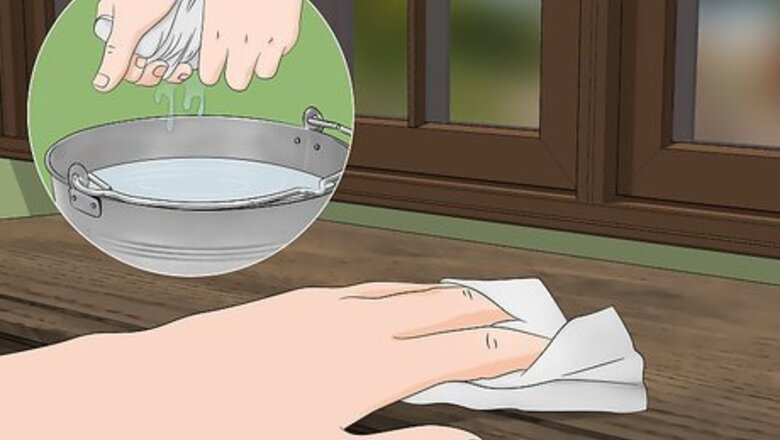
views
Cleaning the House

Dust with a damp cloth. Dust mites feed on dead skin, dander, and other things that are found in dust. Therefore, where there's dust, there are likely dust mites. A key to eliminating dust mites is getting rid of their food source, and that means dusting with a damp cloth. Rinse the cloth regularly to avoid spreading dust. It's important to use a damp cloth, because a dry cloth will just stir up allergens and spread dust around the house. The exception is using a dry microfiber cloth since it traps dust instead of spreading it. Items to dust include furniture, shelves, books, decorations, trinkets, pictures, fixtures, and other items that collect dust.
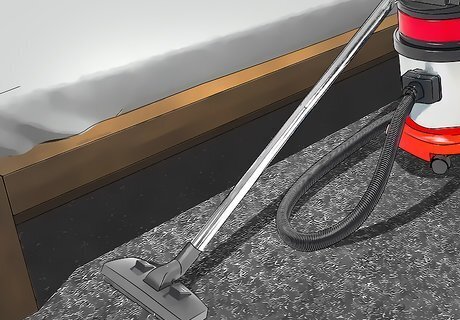
Vacuum the entire house. Vacuuming is another great way to get rid of dust, skin, dust mite feces, and other allergens from your house. To avoid spreading dust and allergens, it's important that you use a vacuum outfitted with a HEPA filter that will trap allergens and prevent them from being blown around the house. When vacuuming, pay particular attention to floors, baseboards, furniture, carpeting, rugs, and behind and underneath furniture. Bagged vacuums are better than ones with a canister since dust could easily get back in the air when you empty it. Use upholstery attachments to get the seams, crevices, and corners of your furniture.

Wash your bedding in hot water. Dust mites can be found all over your bedding. Remove the pillowcases, sheets, blankets, and covers from your bed. Place the items in the washing machine and wash them with hot water and the regular cycle. When the washing machine is done, transfer the items to the dryer and dry them on a hot setting. To kill dust mites, the washing machine or dryer must reach between 130 and 140 F (54 to 60 C).

Clean curtains and drapes. Dust mites love heavy curtains as much as they love pillows and bedding. Remove curtains and drapes from their rods or tracks and check the care label for washing instructions. For washable curtains, remove any hooks or hangers. Transfer the curtains to the washing machine and wash them with hot water. Transfer them to the dryer or hang them to dry according to the care label. Some curtains may be dry clean only. Take the curtains to a dry cleaner to kill dust mites. You can vacuum blinds and curtains using the brush attachment on your vacuum.

Wash toys. Toys, stuffed animals, and other fabric items are great hiding places for dust mites. Collect all washable items and wash them in the washing machine using hot water. Transfer the load to the dryer and dry the items on high heat.
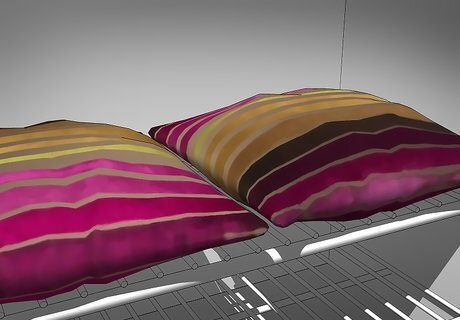
Freeze items that can't be washed. There are some items that you won't be able to machine wash to kill dust mites. With these items, you can freeze them instead to get rid of mites. Transfer each item to a separate plastic bag, and seal the bag tightly. Transfer the item to the freezer and leave it there for 24 hours. Good candidates for freezing include: Pillows Special toys Delicate fabrics
Creating an Anti-Dust Mite Environment

Reduce humidity levels in the house. Dust mites love high humidity. The easiest way to decrease the humidity in your house is with a dehumidifier. You can also decrease the humidity by opening windows on dry days. Always use fans and vents when cooking, showering, and other activities that create steam. By reducing the humidity in your house, you can create an environment that's not ideal for dust mites, and you will slow down how quickly they reproduce. Install a hygrometer to keep an eye on the humidity, and keep the level below 50 percent. Adjust the temperature in your rooms. "I was able to implement specific recommendations to treat my dust mite problem. Turning down the temperature in rooms allowed me to see great improvements." - Eloise S. Wash your bedding. "I decided to get new mattress along with a dust cover. The salesman suggested I wash it weekly along with the sheets, which really worked." - Florence N. Try at home remedies. "Using eucalyptus oil to reduce the spread of dust mites was helpful. Using a damp cloth was a good addition to furniture polish and dry dusting." - Judith L. Do a deep cleanse. "I washed everything from my bedroom in hot water. Before, my sinuses were constantly swollen and nasal passages clogged before. After the thorough washing, I slept much better. My nasal passages were open and sinuses no longer as swollen." - Ginger P. Eliminate problem sources. "Using a dehumidifier and a damp cloth with alcohol were great help. This helped me identify that my cloth furniture and carpet were contributing to my problems!" - Tonee J. We want to hear from you! Advice from our readers makes our articles better. If you have a story you’d like to share, tell us here.

Turn down the temperature. Dust mites also love high temperatures. The ideal temperature for them is between 75 and 80 F (24 and 27 C). In winter, set your thermostat to 70 F (21 C), and even cooler in the bedroom if that's comfortable. In summer, use fans, windows, and air conditioning when necessary to keep your house cooler.

Spray your home with a disinfecting spray. Disinfectants like Lysol are ideal for killing dust mites, and will make your home inhospitable to them. After your regular dusting, spray the disinfecting spray everywhere that dust tends to collect, including: Corners Baseboards Floors Shelves Curtains Near furniture

Use eucalyptus. Certain essential oils, and eucalyptus specifically, are effective at killing dust mites. There are a few ways you can use eucalyptus around the house to make your home unfriendly for dust mites, including: Add 20 drops of eucalyptus oil to your washing machine, especially when you're using a cold or warm water setting. Pour about 30 drops of eucalyptus oil into a spray bottle and fill the bottle with water. Use the spray around the house, including on your bed, furniture, pillows, toys, carpets, and other areas where dust mites live.
Controlling Dust Mites
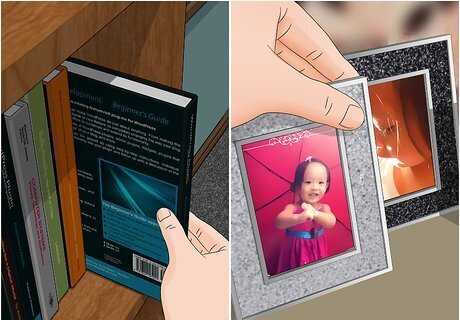
Get rid of clutter. Clutter and unnecessary items around the house attract and trap dust, and this creates a feeding frenzy for dust mites. One of the best ways to get rid of dust mites is to eliminate their food source, and while it's not possible to completely get rid of dust, you can reduce it by throwing out, selling, or properly storing items like: Books Decorations and ornaments Picture frames Trinkets Home accessories Decorative pillows
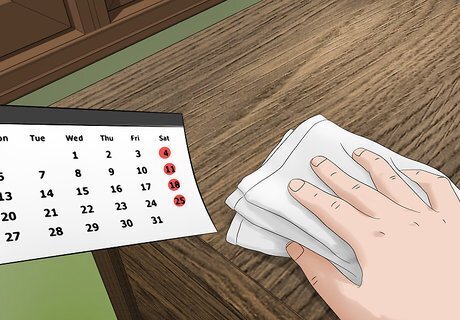
Dust regularly. Regular dusting with a damp cloth is a great way to reduce dust in the house and eliminate food sources for dust mites. Always dust by wiping surfaces with a damp cloth to avoid spreading dust and other allergens around the house. For the best results, dust your entire house on a weekly basis.

Wash linens and bedding regularly. Because linens and bedding are such a hot spot for dust mites, it's important to keep these clean. Weekly washing in hot water that's between 130 and 140 F (54 to 60 C) will help to control dust mites in your bedroom. Be sure to wash: Sheets Pillowcases Duvet covers Blankets

Get rid of carpeting. Carpets and rugs are among the worst places in your house for harboring dust mites. While regular vacuuming and washing (for small rugs) will help to reduce mite numbers, getting rid of the carpet altogether will be even more effective. When possible, remove carpeting and replace it with: Tile Hardwood Laminate Cork Concrete
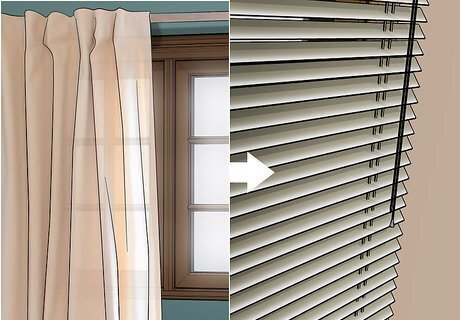
Replace dust-collecting fabrics with easy-to-clean items. Because things like thick curtains and drapes can house large numbers of dust mites, you can help get rid of them by replacing these items. For instance, you can replace curtains with plastic blinds or wooden shutters, and fabric cushions and pillows with leather or pleather ones. Not only are these items easier to clean, but they also won't attract dust mites the way fabrics do.
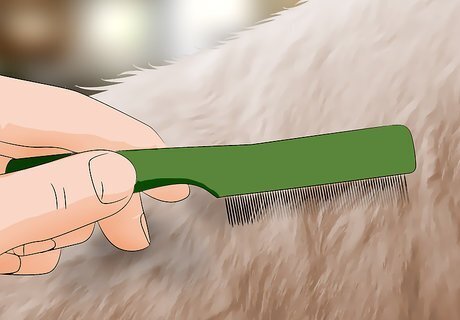
Groom pets regularly. Pet dander is another huge food source for dust mites. To reduce dander in the house, take your dogs and cats outside daily for a thorough brushing. For dogs, you should also give them monthly baths to reduce dander and fur around the house. Pets can also suffer from dust mite allergies, so keeping them cleaner is beneficial for you both.

Use mattress and pillow covers. Mattress and pillow covers are plastic or hypoallergenic fabric envelopes that protect your bed from dust mites, bed bugs, and allergens. The covers encase your mattress or pillows and prevent dust mites from getting in, and protect you from allergens that are already present. To keep these covers clean, wipe plastic ones with a damp cloth and wash fabric ones weekly.

Increase the ventilation in your house. Better ventilation means lower humidity, more airflow, and less dust, and all of these are good for controlling dust mites. You can improve ventilation by opening windows, using ceiling and portable fans, and by making use of vents in the house, such as in the kitchen and bathroom.
















Comments
0 comment